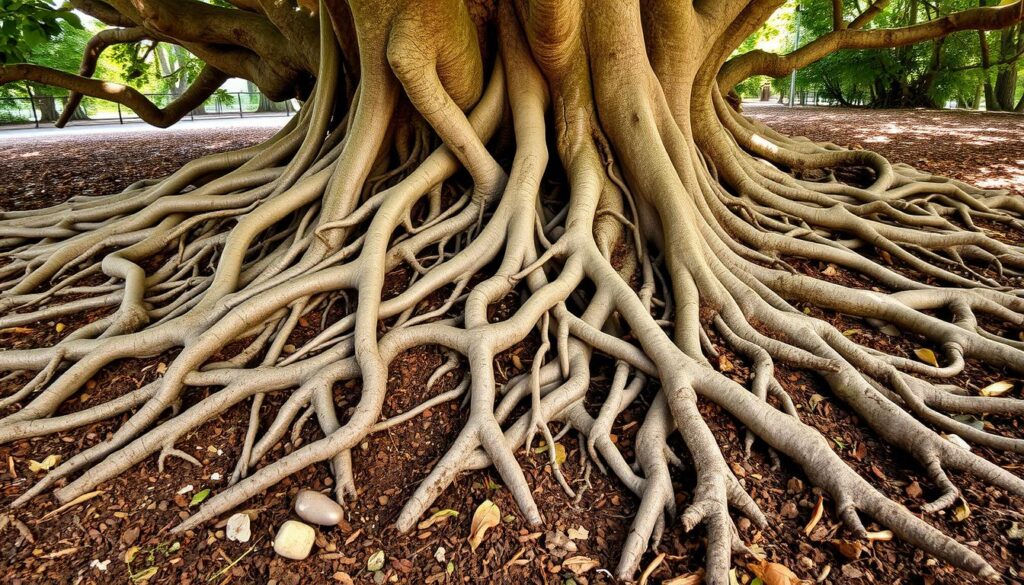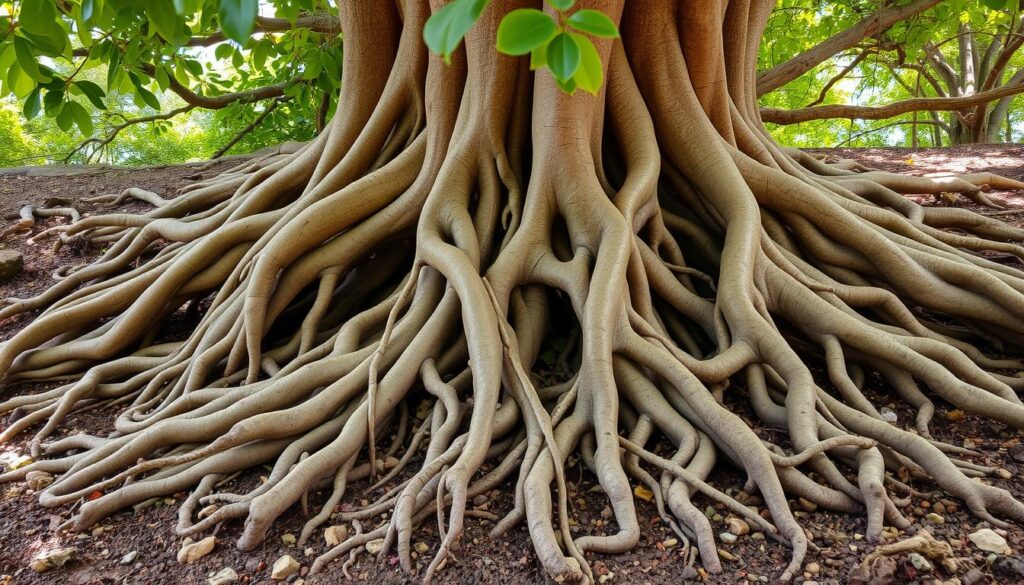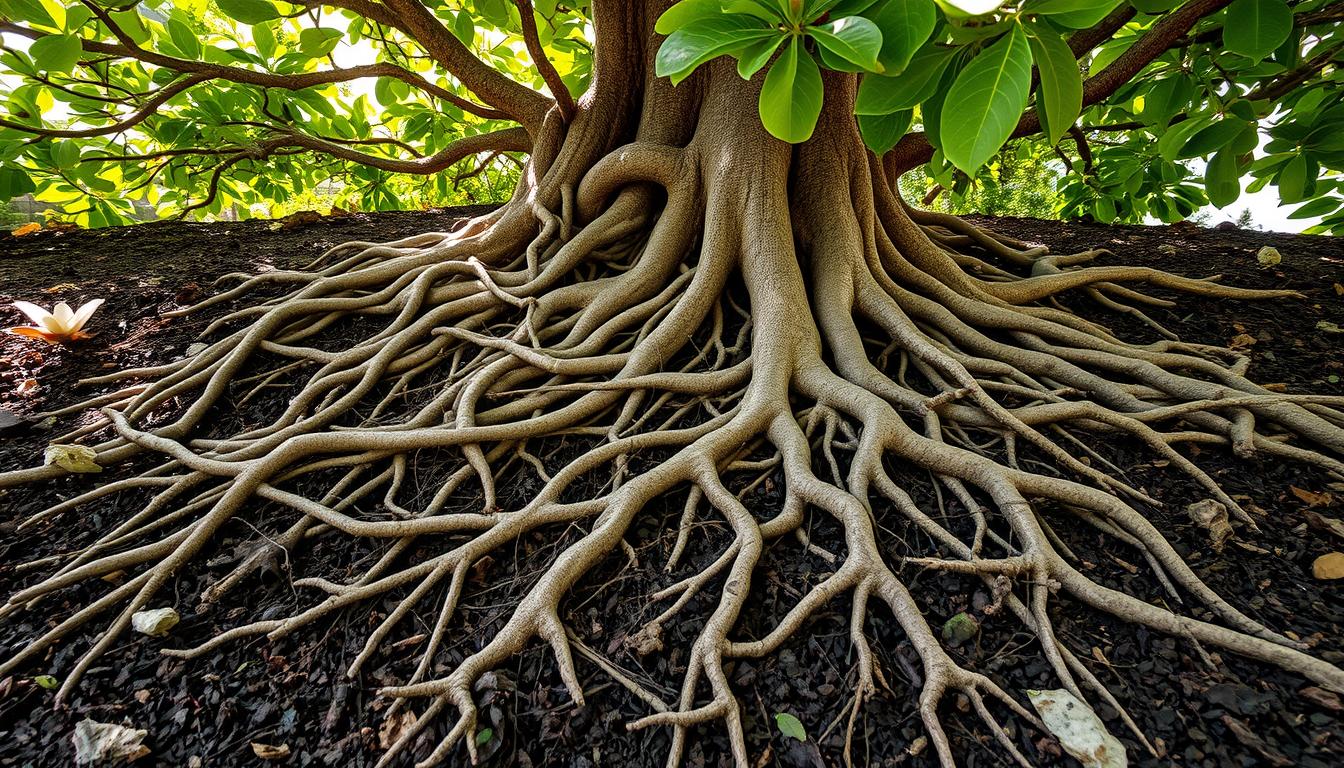The magnolia tree is a stunning addition to any garden. It has beautiful flowers and striking foliage. But, its root system can be a mystery to many gardeners.
Understanding the magnolia tree root system is key for a harmonious garden design. The roots spread out a lot and can affect garden space. It’s important to think about this when planting.
The roots of the magnolia tree are vital for its health. The root system can change based on soil type and climate. Knowing about the root system helps gardeners create a great environment for their magnolia trees.
Table of Contents
Key Takeaways
- Understanding the magnolia tree root system is essential for planning a harmonious garden design.
- The magnolia tree root system is expansive and can impact garden space.
- The magnolia tree roots play a vital role in the tree’s overall health.
- The magnolia root system can be influenced by various factors, including soil type and climate.
- Proper care and maintenance of the magnolia tree root system can support the tree’s growth and overall health.
- Engaging in sustainable gardening practices, including the cultivation of magnolias, contributes to the reduction of carbon emissions and enhances local biodiversity.
- Watering is advised in the fall and early winter to maintain adequate moisture in the root system of magnolia grandiflora.
Understanding the Magnolia Tree: An Overview
Magnolia trees are famous for their beautiful flowers and shiny leaves. They need specific care to grow well. Knowing about their characteristics, types, and how they grow is key. A magnolia tree root system diagram helps gardeners see the tree’s roots. It’s important to think about if will magnolia tree roots damage house foundations.
Key Characteristics of Magnolia Trees
Magnolia trees have big, showy flowers and dark green, glossy leaves. They can grow up to 60-80 feet tall. Their roots spread out a lot, going beyond the tree’s canopy.
Common Species of Magnolia
There are about 125 types of magnolia plants. Some popular ones are the Southern Magnolia (Magnolia grandiflora), Star Magnolias (Magnolia stellata), and Saucer Magnolias (Magnolia soulangeana). Each type is different, with its own look and needs.
Habitat and Growth Conditions
Magnolias like moist, well-draining, acidic soil. They need regular water, more when they’re young. A balanced fertilizer in spring helps them grow. Most magnolias are hardy in zones 4 through 9.
The Importance of Root Systems in Trees
Understanding tree roots is key to keeping them healthy and stable. The root system, including magnolia tree invasive roots, anchors the tree, absorbs water and nutrients, and stores food. The depth and spread of roots vary based on soil conditions and tree type.
A healthy root system is vital for tree health. Magnolia tree invasive roots can be a challenge, but with care, the tree can flourish. Magnolias need special care due to their unique root system.
Functions of Tree Roots
Tree roots do several important things:
- Anchoring the tree
- Absorbing water and nutrients
- Storing food
How Roots Support Tree Health
Knowing how roots support tree health helps gardeners care for them better. This includes ensuring good soil drainage, avoiding too much water, and giving enough nutrients.
Magnolias Compared to Other Trees
Magnolias have a unique root system compared to other trees. While some trees, like poplars and honeylocusts, have deep roots, magnolias have shallower, wider roots.
Exploring Magnolia Tree Root Systems
Magnolia trees have a complex root system. It includes taproots and fibrous roots. Knowing about the roots is key for gardeners. It helps them see if do magnolia trees have invasive roots that could harm nearby things or plants.
Looking into does magnolia tree have invasive roots means checking the types of roots. The roots’ depth and spread change with the tree’s age and type. Younger trees have smaller roots, while older trees have bigger ones.
- Root type: Taproots or fibrous roots
- Root depth: Changes with age and type
- Root spread: Can be wide, possibly invasive
Knowing about magnolia tree roots helps gardeners care for their trees better. It also lowers the chance of invasive roots causing trouble.
Factors Influencing Magnolia Root Growth
Several factors affect how magnolia tree roots grow. These include the soil type and quality, the climate and weather, and how much water is available. Knowing these factors helps gardeners create the best environment for their magnolia trees to grow well.
A healthy root system is key for a magnolia tree’s health and strength. Magnolia tree roots spread out but usually stay within the top 12 to 18 inches of soil. As the tree grows, its roots can spread up to four times the width of its canopy.
Soil Type and Quality
The soil’s type and quality greatly influence magnolia tree roots. For instance, in heavy clay soils, roots grow closer to the surface. This can lead to problems with nearby structures. In sandy soils, roots grow deeper, but in clay soils, they may struggle to grow.
When evaluating soil for magnolia trees, consider these factors:
- Soil pH: Magnolia trees do best in slightly acidic to neutral soil, with a pH of 6.0 to 7.0.
- Soil texture: A mix of sand, silt, and clay that drains well is best for magnolia trees.
- Organic matter: Adding compost or well-rotted manure can make the soil more fertile and structured.
Climate and Weather Conditions
Climate and weather also affect magnolia tree roots. For example, roots grow faster in spring when it’s warmer and wetter. But, extreme weather like drought or flooding can stress the tree and slow root growth.
By understanding what affects magnolia root growth, gardeners can improve their trees’ conditions. This includes choosing the right soil, providing enough water and nutrients, and protecting the tree from harsh weather.
| Soil Type | Root Depth | Root Spread |
|---|---|---|
| Clay | 10-15 feet | 20-30 feet |
| Sandy | 15-20 feet | 30-40 feet |
| Loam | 12-18 feet | 25-35 feet |
How to Assess Root Health in Magnolia Trees
Checking the root health of magnolia trees is key for their health. A magnolia tree root system diagram helps gardeners see the root structure. This lets them spot problems, like damage to house foundations, and fix them early.
The question of will magnolia tree roots damage house foundations depends on the root diagram and soil type. The size of the tree also matters.
To check root health, look for signs of strong, fibrous roots. Be aware of common problems like root rot and nutrient shortages. Fixing these might mean adjusting soil pH, adding nutrients, and watering right.
- Soil quality and pH
- Water availability and drainage
- Nutrient levels and fertilization
- Pest and disease management
By watching these factors and acting early, gardeners can help their magnolia trees grow strong roots. This prevents damage to the trees.
Best Practices for Planting Magnolia Trees
Planting magnolia trees requires careful planning. The right location is key. They need full sun to partial shade, so choose a spot with at least 6 hours of direct sunlight. Knowing if magnolia trees have deep roots or magnolia tree invasive roots helps in planning your garden.
Soil preparation is also important. Magnolias like well-drained, slightly acidic soil with a pH of 5.5 to 6.5. Adding compost or manure can enrich the soil. Make sure to plant them far enough apart, as they can grow up to 80 feet tall and 40 feet wide.
Some key considerations for planting magnolia trees include:
- Planting in the right location with adequate sunlight and soil conditions
- Preparing the soil with organic matter and ensuring proper drainage
- Ensuring proper spacing to accommodate the tree’s mature size

By following these best practices, gardeners can give their magnolia trees a great start. This helps them grow well and avoids problems with magnolia tree invasive roots or other issues.
| Tree Species | Mature Height | Mature Width |
|---|---|---|
| Bracken’s Brown Beauty Magnolia | 30-40 feet | 20-25 feet |
| Little Gem Magnolia | 20-25 feet | 10-15 feet |
Mulching and Its Benefits for Magnolia Roots
Mulching is a simple yet effective way to promote healthy root growth in magnolia trees. By applying a 3-4 inch layer of mulch around the tree, gardeners can help retain moisture, suppress weeds, and regulate soil temperature. This is essential for the magnolia tree root system, as it helps prevent damage and promotes healthy growth.
Some of the benefits of mulching for magnolia tree roots include:
- Retaining moisture in the soil, reducing the need for frequent watering
- Suppressing weeds, which can compete with the tree for nutrients and water
- Regulating soil temperature, keeping it cooler in the summer and warmer in the winter
When applying mulch, it’s essential to start an inch away from the trunk to prevent damage. The mulch should be applied to just past the dripline, helping to retain water effectively for the tree. By following these tips and using the right type of mulch, gardeners can provide their magnolia trees with the best possible care and promote healthy root growth.
| Mulch Type | Benefits |
|---|---|
| Organic Mulch | Retains moisture, suppresses weeds, regulates soil temperature |
| Inorganic Mulch | Provides decorative appeal, can help with weed suppression |
Pruning and its Impact on Root Systems
Pruning is key for keeping magnolia trees healthy and looking good. But, it can also hurt the roots. Knowing how pruning affects roots is important to avoid harming your trees. A magnolia tree root system diagram helps you see the roots and plan pruning.
When you prune a magnolia tree, think about how it might affect the roots. Many gardeners worry about will magnolia tree roots damage house foundations. To avoid problems, plant magnolias far from buildings and other structures.
Here are some tips for pruning magnolia trees:
- Prune in the late winter or early spring, before new growth begins.
- Remove dead or damaged branches to promote healthy growth.
- Use proper pruning techniques to avoid damaging the tree or its roots.

By following these tips and thinking about the root system, gardeners can help their magnolia trees grow well. This way, they can avoid damaging their trees.
| Pruning Technique | Impact on Roots |
|---|---|
| Proper pruning | Promotes healthy root growth |
| Improper pruning | Can damage roots and affect tree stability |
Common Issues with Magnolia Tree Roots
Magnolia trees face several common problems, like root rot and invasive roots. It’s key for gardeners to know the causes and how to prevent these issues. For example, magnolia tree care means being mindful of magnolia tree invasive roots that can harm plumbing and foundations.
One major worry with magnolia trees is their roots becoming invasive. Do magnolia trees have deep roots? They can grow up to 80 feet tall, but their roots spread out and stay close to the surface. This makes it more likely for them to hit plumbing and cause damage.
To lessen these risks, it’s important to plant magnolia trees in a spot with enough room for their roots. Regular care, like pruning, can also stop problems with magnolia tree invasive roots. By doing these things, gardeners can help their trees grow well and avoid damage.
Magnolia Trees and Compaction Issues
Soil compaction can harm the magnolia tree root system. It makes it harder for trees to take in water and nutrients. This also raises the chance of root diseases. Knowing this is key for gardeners, as soil compaction can be very bad for magnolia trees.
The magnolia tree roots are not as deep as some other trees. This makes them more at risk from soil compaction and dry soil. The World of Garden Plants says that drought can hurt early-flowering trees like the Southern Magnolia. To fix this, gardeners can improve the soil and make raised beds.
Some ways to fight compaction include:
- Improving soil by adding perlite or sand to help water drain
- Building raised beds to stop water from pooling around the roots
- Changing how often you water based on the soil’s moisture
It’s important to check on Southern Magnolia trees often. Catching problems early can stop root rot from getting worse. By understanding how soil compaction affects magnolia tree roots and fixing it, gardeners can help their trees grow strong and healthy.

Sustainable Practices for Magnolia Care
Keeping magnolia trees healthy requires more than just basic care. Sustainable practices help support the tree’s roots and boost its overall health. Using natural mulches and avoiding harsh chemicals can improve soil health and encourage good microorganisms.
Creating a diverse ecosystem around the roots is also key. This approach helps the tree stay strong and resilient.
Long-term care is vital for magnolias to thrive. Regular checks, proactive maintenance, and fixing any problems early on are important. This helps prevent damage to house foundations and ensures the tree grows well.
By taking a holistic and sustainable approach, gardeners can keep their magnolias vibrant. This makes the landscape healthy and balanced for many years.
Frequently Asked Questions
Do magnolia trees have invasive roots?
Yes, many magnolia trees have wide-spreading, shallow roots that can extend well beyond the canopy. Some species, especially Southern magnolias, can be aggressive in their search for moisture, potentially interfering with nearby structures, sidewalks, and other plants.
Will magnolia tree roots damage house foundations?
Magnolia roots don’t typically break foundations, but they can cause issues if planted too close to a structure. Their roots grow outward rather than deep, so they can lift sidewalks, driveways, and even disrupt underground plumbing if planted too close. Keeping them at least 15–20 feet away from buildings helps prevent problems.
Can magnolia trees be planted close to a house?
It depends on the variety. Smaller magnolia species, like Little Gem or Jane Magnolia, can be planted closer (around 8–10 feet from a house). However, larger varieties, like Southern magnolias, should be planted at least 15–20 feet away to prevent root interference and allow proper growth.
How deep are the roots of a magnolia tree?
Magnolia roots are typically shallow but wide-spreading. While they don’t grow very deep (usually within the top 12–24 inches of soil), they can extend outward three to four times the width of the tree’s canopy. This is why they need plenty of space to thrive.
What are the disadvantages of a magnolia tree?
Leaf and debris cleanup – Magnolias drop leaves, seed pods, and flowers throughout the year.
Large size – Some varieties grow very tall and wide, requiring lots of space.
Root spread – Their roots can be invasive, making them unsuitable for small yards.
Slow growth – Many magnolia trees take years to reach their full size.
Pest and disease susceptibility – They can attract scale insects and are prone to fungal diseases.
Are magnolia trees good to have in your yard?
Yes! Magnolias are beautiful, fragrant, and provide shade. They attract pollinators like bees and butterflies, and evergreen varieties offer year-round greenery. Just make sure to choose the right variety for your space and be prepared for seasonal leaf drop. If you have room and don’t mind some maintenance, a magnolia tree can be a stunning addition to your yard.

